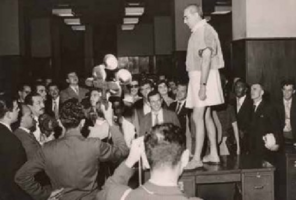The tropical man of the future: a reading through 'Experiência nº 3'
Flávio de Carvalho – artista visual e arquiteto brasileiro — ao longo de toda sua trajetória compôs obras complexas que refletem sobre os modos de viver de seus conterrâneos. Atravessou toda a fase modernista do país e propôs composições criativas que escapam aos padrões dos movimentos artísticos e arquitetônicos contemporâneos de sua época. Para muitos, no Brasil, assume o lugar de diversos pioneirismos em áreas distintas do conhecimento, como arquitetura e teatro modernos, e performance artística.O presente trabalho objetiva interpretar a obra de sua autoria intitulada “Experiência nº 3” (1956), e através de seus significados, tecer análises sobre a sociedade brasileira do período histórico em que foi criada e o atual. A obra em questão é constituída da confecção de um traje e de um desfile de apresentação deste, então, para o aprofundamento de sua leitura, se escolheu interpretar outras obras e desfiles que flertam com a produção e representação de peças de roupas. Há no conteúdo reunido, relatórios de visitas a exposições e desfiles de moda, diálogos com profissionais de moda e esquemas produzidos para acompanhar as conclusões tiradas a partir dos cruzamentos de informações colhidas no decorrer do trabalho.
Flávio de Carvalho – Brazilian visual artist and architect – throughout his career, composed complex works that reflect on the ways of life of his countrymen. He went through the entire modernist phase of this country and proposed creative compositions that escape the standards of contemporary artistic and architectural movements of his time. For many, in Brazil, it takes the place of several pioneering in different areas of knowledge, such as modern architecture and theater, and artistic performance. The present research aims to interpret the work of his authorship entitled “Experiência nº 3”(1956), and through its meanings, to weave analyzes about the Brazilian society of the historical period in which it was created and the current one. The work in question consists of the making of a costume and a parade to present it, so, to deepen its reading, it was chosen to interpret other works and parades that flirt with the production and representation of pieces of clothing. In the gathered content, there are reports of visits to exhibitions and fashion shows, dialogues with fashion professionals and diagrams produced to accompany the conclusions drawn from the crossing of information collected during the work.
